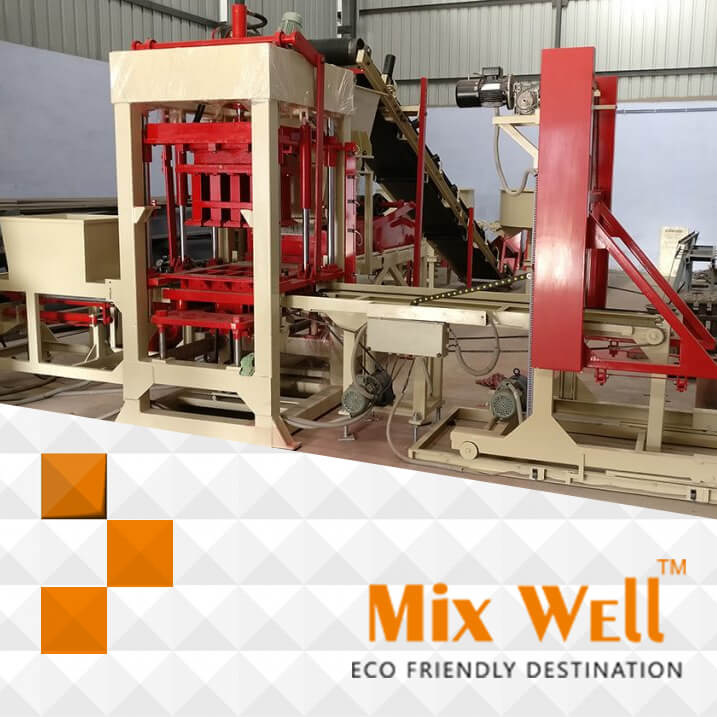
Fly Ash Brick Plant
A Fly Ash Brick Plant is an advanced industrial setup used for the mass production of environmentally friendly bricks using fly ash, a byproduct of coal-fired power plants. These bricks are a sustainable alternative to traditional clay bricks. The plant integrates machinery for material handling, mixing, molding, curing, and stacking — all aimed at producing high-strength, uniform, and cost-effective bricks with minimal manual intervention.
Raw Material Preparation
Materials like fly ash, cement, lime, gypsum, and sand are gathered and stored in silos or hoppers.
Proportioning & Mixing
The materials are proportionally weighed and blended using a pan mixer or concrete mixer for homogeneity.
Brick Molding
The mix is transferred to a hydraulic or vibration press machine which compresses the material into precise brick shapes using molds.
Curing Process
Bricks are either water cured or steam cured for 7–14 days to achieve optimum strength and durability.
Stacking & Storage
Residential and commercial building construction
Government housing projects (PMAY, LIG housing)
Boundary walls, compound walls, and partitions
Paver blocks and landscaping
Industrial sheds and commercial buildings
Uses eco-friendly and industrial waste materials
Supports both manual and fully automated systems
Offers uniform size, finish, and compressive strength
Modular design with options for paver and block production
Compatible with different curing methods (steam/water)
The Fly Ash Brick Plant is vital in addressing India’s environmental and construction challenges. By utilizing fly ash — a waste material — it reduces landfill burden, preserves natural topsoil, and offers a sustainable solution for the ever-growing demand for construction bricks. It supports green construction, lowers material costs, and enables quick project execution.
Eco-Friendly: Helps manage industrial waste and reduces pollution
Strong & Durable: High compressive strength ensures long-term performance
Cost-Efficient: Reduces raw material and labor costs
Faster Construction: Uniform size reduces mortar use and plastering time
Thermal Insulation: Keeps interiors cooler in hot climates
Low Water Absorption: Resistant to seepage and efflorescence
Fly Ash Brick Plants are a cornerstone of sustainable construction in India. They align with national missions like Swachh Bharat Abhiyan, Smart Cities, and Affordable Housing for All. These plants offer environmental benefits while generating economic opportunities through scalable business models across urban and rural areas.
Scalable capacity from 1,000 to 20,000 bricks/hour
Lower production costs and high profitability
Minimal human intervention with automated options
Quick setup and low maintenance requirements
High market demand for eco-friendly construction bricks
Pricing of Fly Ash Brick Plants depends on capacity, automation level, and configuration:
Manual Plant (1,000–2,000 bricks/hr): ₹7 – ₹10 Lakhs
Semi-Automatic Plant (3,000–6,000 bricks/hr): ₹12 – ₹20 Lakhs
Fully Automatic Plant (6,000–15,000+ bricks/hr): ₹25 – ₹50 Lakhs+
Optional Add-ons: Mixers, conveyors, pallet stackers, and curing chambers (additional ₹2 – ₹10 Lakhs)
Note: Prices vary based on region, brand, and customization.
1. What materials are needed for fly ash bricks?
Fly ash, cement, lime, gypsum, sand, and water.
2. Can one plant produce multiple brick types?
Yes, by using interchangeable molds, it can produce solid, hollow, and paver blocks.
3. Is it profitable to set up a fly ash brick plant?
Yes, due to low production cost and high market demand.
4. Do these plants require a large space?
Yes, typically 5,000 to 10,000 sq. ft. is needed for setup and curing.
5. How many workers are required?
Manual: 6–8 workers; Semi-auto: 4–6; Fully auto: 2–3 operators.
6. What is the curing time for bricks?
Usually 7 to 14 days, depending on the curing method.
7. Is the machine maintenance-heavy?
No, regular oiling and cleaning are sufficient for long-term operation.
8. Are government subsidies available?
Yes, for eco-friendly and MSME category businesses under various schemes.
9. Is training provided with the machine?
Yes, manufacturers provide basic operator training and installation support.
10. How long do the bricks last?
Fly ash bricks are known for their strength and durability, often exceeding 50 years.
A Fly Ash Brick Plant is a smart and future-ready investment for entrepreneurs, builders, and infrastructure companies. It blends environmental sustainability with high profitability, offering a powerful tool to meet India’s growing construction demands. Whether you’re starting a new unit or scaling an existing business, this plant ensures low-cost production, superior brick quality, and long-term success in the green construction space.
Office Address
C-1, 77/1, Kaka Estate, Ambicanagar Road, Nr. National Plastic, Odhav, Ahmedabad – 382415, Gujarat, India.
Factroy Address
24, Shreeji Estate Near Sankalp Estate, Bakrol Cir, Ahmedabad-382430, Gujarat, India
mixwellindia@gmail.com
hardicengineering@gmail.com
+91 99042 01922
+91 98984 74351
Also Send Mail
© Hardic Engineering . All Rights Reserved.
